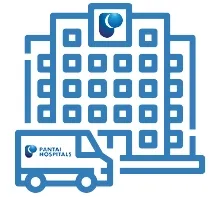A brain injury, a tumour, stroke, aneurysm, brain infection or health problem causes pressure to build up inside the skull. This is a dangerous condition known as increased intracranial pressure (ICP).
The cerebrospinal fluid (CSF) helps to cushion the brain. However, an increase in intracranial pressure has to be treated accordingly.
Popularly known as brain surgery, neurosurgery is a speciality that deals with the diagnosis and surgical treatment of patients with conditions or injuries to the brain and peripheral nerves. It is designed for treating both adults and paediatric patients.
A neurosurgeon is a specialist trained to diagnose and manage conditions affecting the nervous system. Neurosurgeons perform surgical procedures as well as provide nonsurgical treatments.
What is an external ventricular drain (EVD)?
An external ventricular drain (EVD) is a device that temporarily relieves the pressure build-up inside the brain when the normal flow of the cerebrospinal fluid is obstructed.
It is a plastic catheter placed into the intracranial space that helps divert fluid from the external ventricles of the brain or the lumbar space to an external closed system.
The extra ventricular drain is used in situations such as:
- To reduce ICP caused by the build-up of CSF
- To drain infected CSF
- To drain the blood after neurosurgery or due to injury
How is EVD neurosurgery done?
Once the patient is admitted, the EVD sign is placed above the patient's bed, outside the patient's room and at the foot of the bed.
It is vital to ensure that the patient's family members are informed regarding the importance of the monitoring system and the patient's position in bed.
- Levelling and setting up
The drain tube is attached to the ventricle from the operating room. The nurse would set up the device using an IV pole and level the device as per the doctor's suggestion.
- Clamping EVD
The EVD should always be open to drainage except in the following situations:
- While transporting the patient
- Repositioning the patient
- While changing any part of the system
- While obtaining a sample of CSF
- Monitoring
The nurse may need to:
- Ensure that the patient's head has been elevated at least 30 degrees for easy drainage.
- Check for any signs of infection, such as discharge from the exit site, swelling, redness etc.
- The patient’s blood pressure, heart rate, and respiration would be closely monitored.
- CSF sampling
Samples should only be taken if the neurosurgeon requests for.
- Documentation
The CSF drainage and ICP details should be appropriately documented.
What are the contraindications of EVD?
An EVD is contraindicated in the following cases:
- Patients with scalp infection
- Patients who are receiving anticoagulation therapy
- In the presence of a brain tumour
- Patients with Chiari Malformation
- In the presence of any infection in the surrounding area
- The patient with non-communicative Hydrocephalus
What are the complications of EVD?
As this is an invasive procedure, there may be complications.
- Bleeding: Sometimes, the patient is at risk of bleeding from the EVD insertion site, especially if the patient has coagulopathy.
- Infection: As EVD is a foreign object inserted into the brain space, there is a risk of infection.
- Neurological: Neurological symptoms occur when the catheter is inserted too deeply into the brain. Although it is uncommon, it may result in coma if it is not managed on time.
- Mechanical: The mechanical complications are of mainly three types.
- Obstruction - Caused by clotting in the tube. This will cause the pressure to build up, resulting in brain damage.
- Misplacement - Occurs when the EVD is not placed correctly with the tip of the catheter in the third or lateral ventricle. This can be symptomatic if the catheter crosses critical regions of the brain.
- Migration - After the placement of the EVD, it is secured with staples or surgical sutures. However, there is a chance that the EVD could move away from the desired position.
Other complications:
- Seizure
- Stroke
- Leakage of CSF
Nevertheless, EVD neurosurgery is a life-saving procedure to relieve pressure build-up in the brain due to infections or injuries.
Book an appointment at Pantai Hospitals
Get in touch with us to book an appointment today if you would like to know more about EVD. The caring and multidisciplinary team of healthcare professionals are available for consultation and to provide the best care. We assure you the best possible care tailored to your specific needs.
Pantai Hospitals have been accredited by the Malaysian Society for Quality in Health (MSQH) for its commitment to patient safety and service quality.
References
- External ventricular drains: Management and complications. Available at https://www.ncbi.nlm.nih.gov/pmc/articles/PMC4450504/ [Assessed on 14 April 2022]
- NeuroEMCrit – What Every Clinician Should Know about External Ventricular Drains (EVDs). Available at https://emcrit.org/emcrit/external-ventricular-drains-evd/ [Accessed on 14 April 2022]
- Risk factors for hydrocephalus following fourth ventricle tumor surgery: A retrospective analysis of 121 patients. Available at https://journals.plos.org/plosone/article?id=10.1371/journal.pone.0241853 [Accessed on 14 April 2022]
- Caring for neurosurgical patients with external ventricular drains. Available at https://www.nursingtimes.net/clinical-archive/neurology/caring-for-neurosurgical-patients-with-external-ventricular-drains-26-03-2018/ [Accessed on 14 April 2022]


 Request an Appointment
Request an Appointment.webp?sfvrsn=276ce14_1/vector-(3).webp) International Patient
International Patient

.webp)

 Find A Doctor
Find A Doctor



.webp?sfvrsn=20763f7d_21)
.webp?sfvrsn=f2a2c343_12)





